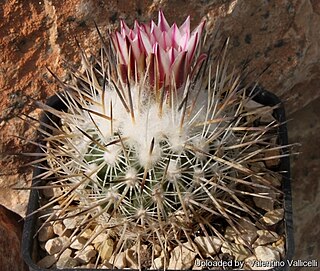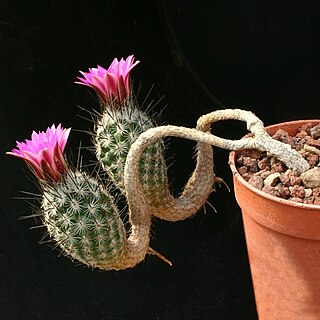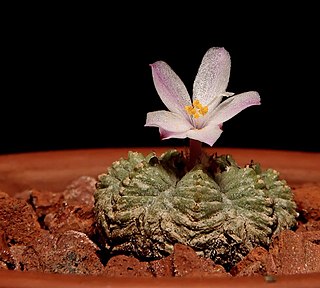
Geohintonia mexicana is a species of cacti, the only species in the genus Geohintonia. This genus is named after its discoverer George S. Hinton. As its specific epithet suggests, the plant is found in Mexico, where it grows on gypsum hills near Galeana.

Obregonia, the artichoke cactus, is a monotypic genus of cacti, containing the species Obregonia denegrii. The species is endemic to the state of Tamaulipas in Mexico.

Turbinicarpus is a genus of very small to medium-sized cacti, which inhabit the north-eastern regions of Mexico, in particular the states of San Luis Potosí, Guanajuato, Nuevo León, Querétaro, Hidalgo, Coahuila, Tamaulipas and Zacatecas.

Astrophytum asterias is a species of cactus in the genus Astrophytum, and is native to small parts of Texas in the United States and Mexico. Common names include sand dollar cactus, sea urchin cactus, star cactus and star peyote.

Ariocarpus agavoides is a species of cactus. It is endemic to Mexico. It grows in dry shrubland in rocky calcareous substrates. Some taxonomists place it in a separate genus as Neogomezia agavoides. The locals use the slime from the roots of the plants as glue to repair pottery. The sweet-tasting warts are eaten and often added to salads

Ariocarpus scaphirostris is a species of plant in the family Cactaceae. The Ariocarpus scaphirostris was originally called Ariocarpus scapharostrus in the 1930.

Cochemiea guelzowiana is a species of plant in the family Cactaceae. The species epithet guelzowiana honors the German cactus collector Robert Gülzow of Berlín.

Turbinicarpus alonsoi is a species of plant in the family Cactaceae. It is endemic to Mexico.

Kadenicarpus horripilus is a species of plant in the family Cactaceae.

Rapicactus mandragora, synonym Turbinicarpus mandragora, is a species of plant in the family Cactaceae.

Kadenicarpus pseudomacrochele, synonym Turbinicarpus pseudomacrochele, is a species of plant in the family Cactaceae.

Turbinicarpus pseudopectinatus is a species of plant in the family Cactaceae.

Turbinicarpus schmiedickeanus is a species of plant in the family Cactaceae.

Rapicactus subterraneus, synonym Turbinicarpus subterraneus, is a species of plant in the family Cactaceae. It is endemic to Mexico. Its natural habitat is hot deserts.

Turbinicarpus valdezianus is a species of plant in the family Cactaceae.

Aztekium ritteri is a species of cactus native to the Mexican state of Nuevo León.

Echinocereus poselgeri, also known as the dahlia cactus, is a species of Echinocereus. It is native to Coahuila and southern Texas.

Mammillaria glassii is a species of cactus native to Mexico. It comprises two subspecies: M. glassii subsp. glassii and M. glassii subsp. ascensionis. In its natural habitat, high in the mountains, it often grows on rocky slopes in the shade. It is grown as an ornamental plant, appreciated for its dense spines and pink flowers, which are especially large in the subsp. ascensionis.

Thelocactus tulensis is a species of cactus. It is endemic to Mexico.

Thelocactus conothelos is a species of cactus endemic to Mexico.






















